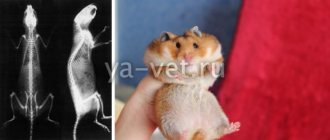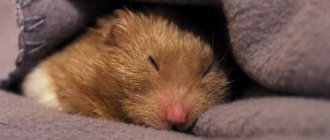Some diseases of Djungarian hamsters are dangerous to humans, so the pet owner must quickly respond to their manifestations. You can’t delay either because diseases in small rodents progress rapidly.
Let's find out what diseases are most common in jungarians, how to recognize them and what to do before visiting the veterinarian.
Contagious diseases of hamsters
Infectious diseases arise as a result of the entry into the body of various pathogenic bacteria and viruses, as well as parasites and fungi. These diseases are much less common among Syrians than non-contagious ones. The animal can become infected from other hamsters, from its owners, as well as parasites and improper food. Dirty, strewn litter can also be a cause of disease. Let's look at the main infectious diseases of hamsters.
Lymphocetal choriomeningitis
A very rare (fortunately) disease that not every hamster gets sick with in their lifetime. Its danger also lies in the fact that the owner can also get sick from it, including from his pet. The disease is carried by mice and other wild rodents. Symptoms in hamsters differ by age: adults with the disease do not have any symptoms, while young ones begin to suffer from difficulty breathing (rarely paralysis, sometimes convulsions). In the case of humans, the virus affects the upper cortex of the brain. This virus is especially dangerous for pregnant women, as it can severely damage the developing fetus. How to avoid this disease:
- do not purchase a hamster at the market or from other unlicensed breeders;
- take only young animals no older than 2-3 months;
- do not get new pets if someone in your family is expecting a child.
Worm infestation
Although worms are not friends of hamsters (and they are not friends of anyone at all), they still very often go through life “hand in hand” with them. An attentive owner can detect symptoms of worm infection by looking at the condition and behavior of the animal. The most obvious is losing weight while maintaining or reducing the pet’s appetite. The reason will also be the slow growth of young individuals. Various fur problems may also occur, such as oily fur.
If the owner does not always pay attention to these signs, sooner or later he will find parasites in the pet’s feces. The situation is not as dire as it looks
In fact, this is one of the few cases where a trip to the vet is not necessary. Just buy deworming medications made specifically for rodents.
Respiratory diseases
These include herpes, influenza, and a number of other infections. Viruses begin an intensified attack on the pet’s immunity when the temperature drops (autumn, winter), increasing the chances of overcoming the body’s weakened defenses. A sick hamster usually suffers from a runny nose and conjunctivitis (discharge from the eyes), and also sneezes frequently. With respiratory infections, the hamster may try to rub its face with its paws. When breathing, wheezing sometimes occurs.
If you provide your pet with good conditions and care, he will recover from the disease on his own in a couple of days. If the animal’s immunity fails, its body becomes open to bacterial infections. The symptoms are still the same, only stronger. The disease can progress to pneumonia, from which the pet can die within a few days. If, after improving conditions, the hamster does not recover, it must be urgently taken to the veterinarian.
Infectious gastroenteritis
The name is scary, although it is a simple infection in the intestines, leading to disruption of its functions. In other words - diarrhea. Also known as "wet tail". In Syrians, the disease is caused by the parasite Lawsonia intracellularis. The disease is very dangerous and can lead to the painful death of a hamster within a few days. Death occurs due to severe dehydration of the body. The animal is rapidly losing all its strength, so it cannot cope with the “wet tail” disease on its own, without medical intervention. To save the rodent, it is given antibiotics and a subcutaneous injection of saline to maintain water balance. You can protect your hamster from this disease by cleaning the cage in a timely manner.
Demodicosis
If larger animals - cats and dogs - are most often attacked by lice or fleas, then hamsters, including Djungarians and Syrians, suffer from microscopic mites. When a tick appears, symptoms will not be long in coming. The hamster begins to itch intensely, and bald patches appear on its fur. This is an allergy or shedding. If you observe these symptoms, take your pet to the veterinarian, where he will receive the necessary injection that kills the tick.
Features of the body of Djungarian hamsters
Improved metabolism. The hamster consumes large amounts of food because it always expends a lot of energy.
Like all other processes, diseases will develop rapidly in a small organism. For example, if an animal is dehydrated from diarrhea due to some kind of gastrointestinal infection, it can die very quickly.
Burdened by genetics. Diseases such as hereditary diabetes mellitus and obesity appear at an early age due to the frequent crossing of two species - the Campbell hairy hamster and the dwarf hamster.
That is why it is good to know what your pet’s ancestors suffered from. And even better - the confidence that they were healthy!
Symptoms and differential diagnosis
The “wet tail” disease is insidious in that it may not appear in an infected hamster for 1-2 weeks. The long incubation period makes it possible to purchase a sick animal. Young animals aged 3-8 weeks are most often affected.
Another name for this bacterial infection is proliferative ileitis, since the ileum is primarily affected. The main symptom is profuse diarrhea, first with water, then with blood. The back half of the animal's body looks wet. There may be rectal prolapse caused by constant intestinal spasms. Due to severe diarrhea, dehydration occurs and hamsters die 2-3 days after the onset of the disease. Diagnosis is made only on the basis of clinical signs. Characterized by a strong fetid odor of feces.
Nonspecific signs of the disease are refusal of food and water, depression (the animals are lethargic and move little). Sometimes the pet's behavior changes: a day or two before the onset of diarrhea, the hamster becomes aggressive, gets nervous when picked up and bites.
It is important to distinguish wet tail disease from other problems in your hamster.
When wondering why the hamster has wet fur, the owner does not always pay attention to the location of the problem. If there is excessive drooling, the fur on the neck and chest will become wet and sticky.
In this case, it is a mistake to say that the hamster is vomiting. In these rodents, vomiting is not possible for anatomical reasons. Problems with teeth or cheek pouches are likely. Wet fur in the nose area means there is discharge and a problem with the respiratory system.
A raw belly and wet tail in a Djungarian hamster are signs of severe diarrhea, but not specific proliferative ileitis. In Djungaric hamsters, “wet tail” is called colibacillosis, “wettaildisease” is a specific problem of Syrian hamsters.
Often the owner cannot understand why the hamster is wet. Looking for a malfunction of the drinking bowl, or deciding that the hamster has peed itself, the owner wastes time.
Fighting the pathogen
Since proliferative ileitis is caused by intracellular bacteria (Lawsonia intracellularis, intracellular bacteria, in Syrians and Escherichia coli, Escherichia coli, in Djungarian hamsters), an antibiotic is needed that can penetrate inside the intestinal cells. The drug itself must be non-toxic for a tiny rodent (chloramphenicol and tetracycline, which are effective in other animal species, are contraindicated in hamsters).
Sometimes a human drug is used (oral suspension): Biseptol (a combination of 2 drugs: trimethoprim + sulfamethoxazole). The widely known Enterofuril (nifuroxazide) can cope with E. coli, but not the causative agent of “wet tail” in Syrian hamsters.
The standard of treatment is the veterinary antibiotic Baytril 2.5%, subcutaneously 0.4 ml (10 mg) per 1 kg of body weight. If the hamster weighs 250 g, its dose is 0.1 ml. The drug in the indicated amount is administered once a day, but in severe cases - 2 times a day, for 7-14 days.
Fighting dehydration
It is the loss of fluid that causes the death of sick animals. With profuse diarrhea, dehydration occurs rapidly. It is useless to drink liquid inside - it will pass through. Intravenous injections (drips) are not given to hamsters due to the small size of the animals. Therefore, intraperitoneal and subcutaneous injections are used. Even the owner himself can inject “in the skin”, under the skin, and injections “in the tummy” are performed by a veterinarian.
They use Ringer's Lactate, and if it is not available, use ordinary saline solution (NaCl 0.9%) at a dose of 40 ml per 1 kg of body weight (4-8 ml for a Syrian and 2 ml for a Djungarian). 5% glucose is also prescribed. Injections should be given 2-3 times a day. To the basic solutions, you can add general strengthening drugs - ascorbic acid, "Katozal".
It is necessary to keep the sick animal warm and dry. The cage is washed daily, the bedding is replaced with fresh ones so that the hamster does not infect itself again and again. Juicy food is excluded. If a hamster has a “wet tail” disease, even timely, competent treatment often turns out to be useless. Without treatment, mortality is 90-100%. Sometimes the owner himself refuses the therapy prescribed for the pet, arguing that the antibiotic is toxic to the liver, and injections are stressful for the hamster. However, these injections for deadly diarrhea are a chance for survival for a tiny rodent.
Other diseases
There are many diseases of hamsters, a complete listing of which would take more than one article. These could be problems with the lungs, the cardiovascular system, or the gastrointestinal tract. They can become paralyzed from stress. Hamsters are very vulnerable to various diseases. The best solution to most problems associated with rodent diseases is proper maintenance and regular prevention.
What does metabolic disorder lead to?
Metabolic disorders can lead to a number of diseases that can affect the entire body of the pet. For example, diabetes, which occurs due to poor nutrition. Metabolic disorders are not the worst thing that can happen to your hamster. Just don't feed or spoil him with things he shouldn't eat. With your kindness you will only cause harm to your pet. If you notice deviations from the animal’s healthy behavior and appearance and think that everything is fine with its diet, be sure to visit a veterinarian.
Dental diseases in hamsters
A hamster's teeth are considered one of the most important indicators of its health. Unhealthy teeth are a reason to think about your pet’s overall health. By the way, yellow teeth are completely normal for rodents, since they have yellow enamel by nature. It may be that your hamster's teeth suddenly turn yellow - this is normal. It is not normal for a small hamster to have huge front incisors. They need to be ground down. There have been cases when huge incisors led to such herbs that ended in the death of the animal.
How can I close his mouth? The teeth are not foldable. So you'll have to go to the vet.
The best prevention in this case is considered to be a mineral stone. A warning sign that should be followed by a trip to the vet is tooth loss.
Inflammation of the cheek pouches
Hamsters have earned their fame largely due to their ability to carry huge (for a hamster) amounts of food. Sometimes it seems that there is not as much space there as there is food he hides there. The place is considered quite vulnerable.
90% of the hamster you see in the picture are cheek pouches.
For example, he can put filler in the form of sawdust there and, as a result, cut himself from the inside, followed by inflammation. If you notice that your hamster's cheeks are larger and there is no food there, or that your hamster is not carrying around as much food as before, take him to your veterinarian for further instructions on how to treat your hamster.
Hair loss in hamsters
The cause of hamster hair loss can vary. From scabies and lichen, to the hamster’s habit of scratching without sparing yourself and your strength. It is also possible that your hamster has become bald due to constant contact with urine. To avoid this, you need to regularly change the bedding and filler. Sometimes baldness is completely natural and does not require intervention.
Agree, Khoma’s look is so-so. All the charm and beauty have disappeared somewhere. This is how constant stress affects you. And the situation is the same with people. Already in college, half of the students have bald patches at the temples.
Hamsters shed from time to time. Also, baldness is normal for older individuals. If the owner is sure that the reason is molting, old age or habit, a trip to the veterinarian is not necessary, although it is advisable.
This is how things are, friends. I tried to tell you everything I know about hamster diseases and how to treat them. I really hope you don't have to go to the vet very often. May your furry live long, warm and well-fed. And most importantly, don’t get sick yourself!
The state of the hamster's nervous system
The animals themselves will never let you know that there are any disorders of the central nervous system. Despite this, all you have to do is make loud noises, take your hamster out into a bright light, give your hamster a ride in a car, or disturb his sleep pattern, and your beloved pet will reveal his entire essence, show it in the literal sense.
You may notice baldness, scabies, and even problems with bowel movements. For transporting little friends, there are ways to safely secure them, invented by veterinarians to prevent unnecessary movement.
Injuries in rodents
Injuries, bruises, fractures in rodents
Can occur when falling from a height or improperly restraining the animal. Sometimes tissue or limbs are pinched. Injury is caused by using cotton wool as bedding instead of hay or sawdust. Lameness that progresses to complete impairment of limb function can result in self-amputation of the paw, especially in hamsters and rats.
Fractures and cracks of bones in rodents
They can happen while playing with children or fighting among themselves, when the cage door is quickly slammed shut. Characteristic signs are that the animal squeals in pain, swelling of the limb, lameness, and hematoma appear. With an open fracture, the bones break through the soft tissue and come out. It is necessary to immediately limit mobility, transfer the rodent to a small box or carrier, and take it to a veterinary clinic for treatment. Bites and wounds occur as a result of a fight with another animal. The wound should be washed with an antiseptic solution (for example, an aqueous solution of Chlorhexidine 0.05%) or saline, the rodent should be transferred to a small cage or box and taken to a veterinary clinic.
Self-treatment of rodents in case of injuries is not recommended, since wounds can become infected, and fractures can lead to further improper healing of bones or complete loss of a limb.
Dental problems
Like any other rodent, hamsters' front teeth are in a state of perpetual growth. However, too fast a pace can cause pain and inconvenience to the animal, because it does not have time to grind them down. Sometimes a bad bite leads to pain in the mouth. Such defects are common and often inherited. It can be noticed by increased salivation and refusal even of favorite treats. It is best to take your pet to a veterinarian, as only he can determine the exact cause and prescribe effective treatment.
Cystitis
Hamsters are very susceptible to hypothermia, so they can easily catch an infection of the genitourinary system, namely cystitis. This disease is characterized by excessive drinking, frequent urination mixed with blood, your pet may behave inappropriately, squeal when defecating, and bald patches may appear on the hind legs.
Cystitis is treated with antibiotics prescribed by a specialist. The disease goes away in 6 days; the main thing is to provide warmth and plenty of fluids for the rodent during this time.
This list will include the most common diseases in hamsters. An experienced owner himself senses if something is wrong with his beloved animal, and he himself can sound the alarm if there is danger. Be attentive to your pets and they will give you many pleasant moments.
What do hamsters, “jungarians” and their Syrian brothers get sick with?
The most common ailments for domestic rodents are mechanical injuries (dislocations, fractures, bruises), metabolic disorders and disorders of the digestive system associated with a violation of the animal’s diet.
Hamsters can get sick from both infectious (viral, bacterial and parasitic) and diseases not associated with an infectious agent. Including oncological pathologies. Hamsters may have helminths and intracellular parasites, lice, fleas, ticks, and skin fungus, but most likely you will not have to encounter these diseases if you follow the rules and regulations for caring for animals.
Contagious diseases in hamsters
An animal can become infected with a bacterial or viral infection in several ways.
- From other sick animals through direct contact or through its waste products.
- Through contaminated food or water.
- Insect bites.
- Through litter and uncollected excrement.
Respiratory infections are activated by hypothermia, stress and lack of vitamins in the body. You can tell that a hamster is sick by its behavior. He will become lethargic and apathetic. You may notice discharge from the nose. The young, strong hamster will recover in a few days. In weak individuals with reduced immunity, the disease can develop into pneumonia. The animal will cough and breathe heavily. In a few days he will die.
Tuberculosis develops in a weakened body when the tuberculosis bacillus enters the body. There are two forms of this disease, depending on the method of infection: pulmonary and intestinal. With the pulmonary form of tuberculosis, the hamster experiences a cough, shortness of breath, and decreased appetite. The intestinal form is characterized by severe diarrhea. This disease of hamsters, unfortunately, is incurable.
To prevent tuberculosis, the animal must receive adequate nutrition with the required amount of vitamins, the cage must be kept clean at all times, and the room must be periodically ventilated. It is necessary to avoid contact with sick animals and people. Not only can humans become infected with certain illnesses from a hamster, but rodents can also suffer from contact with a sick person.
Colibacillosis is an infectious disease of the gastrointestinal tract caused by Escherichia coli. Characterized by very severe diarrhea. The stool is so thin that it looks more like urine, which is why the disease is also called “wet tail.” The hamster becomes lethargic, eats poorly, and quickly loses weight. If you notice such signs, you should urgently take the rodent to the veterinarian. The doctor will examine the symptoms and prescribe treatment. Antibiotics of the tetracycline group are usually prescribed and added to food or drinking water. In severe cases, chloramphenicol injections are prescribed.
Colibacillosis is a highly contagious disease. If the sick animal has been in contact with other pets, they will also have to be treated. The sooner you see a doctor, the more successful the treatment will be. Prevention of the disease - maintaining cleanliness in the cage. As well as keeping each animal in a separate cage.
Cystitis. A wet tail can be an indicator not only of colibacillosis, but also of cystitis - inflammation of the genitourinary tract. The animal experiences pain when urinating and is constantly thirsty. The disease occurs from hypothermia. Maintain the optimal temperature in the room where the baby lives, do not place the hamster’s cage in a draft. Cystitis can also be treated with antibiotics.
Diplococcosis is an infectious disease of the respiratory tract caused by diplococcal bacteria. Symptoms: weakness, lethargy, refusal to eat. The hamster is shaking and trembling, and his nose is running. Death occurs within 2–3 days if a special antibacterial serum is not administered in time.
Salmonellosis is an acute intestinal disease caused by Salmonella Escherichia coli. It also leads to death if treatment is not started in time.
Pneumonia is a common complication after respiratory infections if the patient does not receive proper treatment and proper nutrition. Or if the animal has a lack of vitamins in the body and lowered immunity. The disease can occur after severe hypothermia.
Conjunctivitis is an inflammatory process of the eyes and eyelids. Eye diseases in Djungarians occur from hypothermia or are of a bacterial nature.
Intestinal parasites. You can determine that a pet is infected with worms by looking at its feces and by the fact that with a good appetite the animal loses weight. The condition of the fur is not the same as that of a healthy animal; it is faded or, on the contrary, greasy. In this case, you can buy a complex anti-worm drug (for example, Shustrik) at a veterinary pharmacy.
Demodicosis is a disease caused by a microscopic subcutaneous mite. The animal itches and the hair falls out. The disease is treated with an injection of ivermectin.
Ringworm is a fungal disease. Scaly spots appear on the body and limbs of the rodent, and the fur falls out. The disease is contagious and can be transmitted to humans. The doctor will make a scraping and prescribe treatment with ointments and special creams.
When to sound the alarm?
Few owners notice changes in the condition of their pets in the early stages of the disease. But early diagnosis is the key to a speedy recovery of the animal. How can you tell if your pet has health problems? Of course, conduct an external examination and observe the fluffy for a couple of days. You should:
- assess the animal’s activity: if Homa suddenly becomes lethargic, he is clearly unwell;
- watch your appetite. Healthy animals love to snack. If a pet refuses even its favorite treat, it is seriously ill;
- check the weight. An adult Syrian hamster must weigh at least 90 g; for all other breeds, including Djungarian hamsters, the weight must not be less than 30 g;
- examine your pet's face. The eyes should be shiny, without cloudiness or mucus. Nose – cool, without discharge. Check your ears for flaking. Pay attention to the incisors: they should grow evenly;
- make sure that there are no skin growths or tumors on the neck, armpits and abdomen;
- inspect the butt and the area of fur under the tail, they should not be wet or dirty;
- the living space also needs to be examined: if the rodent has an intestinal disorder, the stool will be liquid, and if it has cystitis or diabetes, you will understand it by the smell.
If at least one sign is detected, it is worth taking the fluffy to the veterinarian so that he can make a diagnosis and prescribe treatment.
What is lichen?
This is a skin disease of viral origin, caused by fungi that can only be seen under a microscope.
The main signs of the disease are rashes on the skin in the form of pink, ringing or weeping spots, as well as the appearance of inflamed areas, in the place of which hairless spots appear, and the hairs themselves break off at the root. With lichen, there is constant itching, which is why the animal scratches the skin vigorously, resulting in the formation of crusts that begin to peel off. The pet’s appetite also worsens. The incubation period lasts from 10 to 30 days.
If your furry friend exhibits these symptoms, you should contact your veterinarian immediately, as shingles is often confused with a common allergic reaction. During the examination, the veterinarian uses a special device - a fluorescent lamp, with which you can clearly see fungal spores, which fluoresce when hit by a light beam. But an accurate diagnosis is established only after laboratory tests.
Diseases of the skin, fur and claws
Alopecia
There are many reasons for hair loss that is not associated with seasonal shedding in animals.
Usually this:
- stress;
- lack of nutrients;
- inflammatory diseases of the gastrointestinal tract;
- parasitic and fungal infections.
For any reason of illness, the animal needs to ensure a quiet existence, harmonize and fortify the diet.
In case of ringworm or parasitic infections, specific treatment is required.
Dermatomycoses
Most often these are microsporia and trichophytosis. With fungal infection of the skin and fur, the animal not only loses its hair, the hairs look broken at the root, sores and crusts appear on the skin. The animal is bothered by severe itching.
Dermatitis
Hamsters can have an allergic reaction, for example, to bedding. It is manifested by skin itching, tissue hyperemia, the appearance of various elements of the rash, and scratching.
Parasites
Helminthiasis can lead to deterioration in wool quality. Parasitism of lice and fleas leads to skin itching, tissue damage, and the formation of tangles.
Mouse pox
This disease is more common in rats and mice, but sometimes hamsters are also infected. In the acute course of the disease, the animal dies with minimal symptoms. With a less pronounced process, the hamster’s paw swells, closer to the sole, and blisters form on the skin. The paw hurts greatly, the process ends with gangrene and loss of the limb.
Signs of the disease
Hamsters are quite fragile animals. Due to their small size, they can easily be injured even in their own cage. In addition, improper living conditions or mistakes made by the owners can lead to illness in the hamster
It is very important to recognize in time that something is wrong with your pet and help him as soon as possible, because any delay will only worsen the situation. You should especially carefully monitor older hamsters, because over time their body wears out, and it is more difficult for them to cope with the disease
The main signs of hamster disease:
Change in activity and daily routine. Hamsters are nocturnal animals, which means they must sleep during the day and wake up at night and run around in a wheel. If the hamster has become inactive, does not leave the house and constantly sleeps, this is a reason to sound the alarm. Changes in the condition of the skin and coat. Ideally, there should be no bald spots on a hamster's fur. It should be smooth and soft
If your hamster has bald patches, wounds on the skin, or the fur is constantly dirty, then you need to pay attention to the condition of the pet. The hamster cannot open its eyes, they are swollen, fluid is oozing from them, or the eyes are white, you need to take immediate action. Diarrhea in a hamster is a very dangerous phenomenon, as is constipation. Blood in urine and stool. Refusal to eat. Watery or purulent discharge from the nose or mouth. The hamster drags its paws or moves strangely. Tumors that appear on the body. Strange behavior. For example, a hamster may fall on its back, somersault, twist, throw its head back, and suddenly become very aggressive.
Hamsters are very often injured - they break their paws, spine or get open wounds. They are afraid of cold and drafts, which can cause them to catch a very serious cold. Hamsters are carriers of parasites. They are also susceptible to infectious diseases. Therefore, if you notice even one sign of illness in your pet, you must urgently take it to the veterinarian to determine the exact cause of the oddities.
Fungal infections
Fungi parasitize the skin epithelium of furry animals and can be located on the paws and ears. As a result, hamsters develop various sores, dandruff, and itchy skin on their bodies. If the problem is not solved in time, the animal will scratch itself into deep scratches, bacteria will settle in them and inflammatory and putrefactive processes will begin.
What do hamsters suffer from, what mycoses?
- Dermatophytosis. The skin peels off, ulcers appear, and the fur begins to come out. Dermatophytosis must be treated with special solutions (chlorhexidine, miramistin), ointments or shampoos, which must be prescribed by a veterinarian.
- Lichen. In areas that have lost hair, fresh wounds and drying crusts are visible. The disease is contagious, so do not keep a healthy hamster in the same cage as a sick one. The sore is diagnosed by scraping and treated with special creams and ointments. If the hamster has no wounds or peeling on the skin, but the hair has fallen out, then this is not lichen, but vitamin deficiency.
- Trichomonosis. A hamster can become infected with this parasite through dirty water or low-quality food. Young animals under the age of one year become ill more often. The symptom is unique and easy to recognize: a yellow tint to the throat from the inside. Over time, a swelling appears there, preventing the animal from breathing. To prevent infection, it is necessary to frequently disinfect the cage, monitor the quality of food and utensils, and the cleanliness of all objects with which the animal comes into contact.
Reasons for premature departure
Death during childbirth
Sometimes babies are stillborn. Sometimes the following may happen during the birth process:
- the giving birth female dies;
- newborn puppies die;
- Both mother and newborns die.
The main reason for the death of a female in childbirth is too early pregnancy. In this case, labor is weak, the fetuses that died inside the womb decompose and the animal dies.
The process is fleeting. Sometimes the female manages to give birth to several completely alive and strong hamsters, and then dies. In this case, the owner is faced with the question of what to do with the offspring. If there is no experience and opportunity to feed the offspring every 2 hours with a special milk formula and warm them, then it is wiser to euthanize the newborns. Otherwise, any error in care will cause illness and death of pets.
The birth of stillborn cubs or their death in the first minutes of life and the subsequent death of the female indicate not only a pathological birth, but also a previous illness.
During or after a fight
Hamsters fight very fiercely. In the wild, hamsters live alone, so at home they will protect their home from their fellows.
In this case, rodent fights end in death.
It is almost impossible to save an animal from lacerated bite wounds; if the fight happened at night, then most likely a dead animal will be found in the cage in the morning.
After or during anesthesia
If a sick or injured hamster is treated under anesthesia, the animal may fall asleep so deeply that it gradually stops breathing and cardiac activity.
Sudden death
A pet hamster can die due to general health. The causes of sudden death are heart attacks or strokes. Such disorders are associated with the functioning of blood vessels and the heart; they are quite typical for these rodents. Sudden cardiac arrest may be the result of severe fright, such as that caused by a sudden attack by a cat.
Death from boredom
By nature, hamsters are loners. During the breeding season, they do not form social groups, and the female spends only a few hours with the male. If after mating the partner does not leave in time, then he may become a victim of the female, who in these animals can be larger and stronger. Therefore, you should not attribute human feelings and emotions to a rodent; they are not capable of dying of melancholy if the cage is cleaned and there is food and water.
What do healthy hamsters look like?
In principle, it is easy to distinguish a healthy hamster from a sick one. In normal condition, the animal has beautiful, shiny fur, smooth breathing without shortness of breath, and no discharge from the eyes and nose. In terms of behavior, the animals are curious, playful, with a good appetite, and active (if this is the time of wakefulness). It is also very important to assess the condition of the eyes; they should not only be clean, but also clear and shiny. Healthy hamsters have a dry nose.
Other diseases
There are many diseases of hamsters, a complete listing of which would take more than one article. These could be problems with the lungs, the cardiovascular system, or the gastrointestinal tract. They can become paralyzed from stress. Hamsters are very vulnerable to various diseases. The best solution to most problems associated with rodent diseases is proper maintenance and regular prevention.
What does metabolic disorder lead to?
Metabolic disorders can lead to a number of diseases that can affect the entire body of the pet. For example, diabetes, which occurs due to poor nutrition. Metabolic disorders are not the worst thing that can happen to your hamster. Just don't feed or spoil him with things he shouldn't eat. With your kindness you will only cause harm to your pet. If you notice deviations from the animal’s healthy behavior and appearance and think that everything is fine with its diet, be sure to visit a veterinarian.
Dental diseases in hamsters
A hamster's teeth are considered one of the most important indicators of its health. Unhealthy teeth are a reason to think about your pet’s overall health. By the way, yellow teeth are completely normal for rodents, since they have yellow enamel by nature. It may be that your hamster's teeth suddenly turn yellow - this is normal. It is not normal for a small hamster to have huge front incisors. They need to be ground down. There have been cases when huge incisors led to such herbs that ended in the death of the animal.
How can I close his mouth? The teeth are not foldable. So you'll have to go to the vet.
The best prevention in this case is considered to be a mineral stone. A warning sign that should be followed by a trip to the vet is tooth loss.
Inflammation of the cheek pouches
Hamsters have earned their fame largely due to their ability to carry huge (for a hamster) amounts of food. Sometimes it seems that there is not as much space there as there is food he hides there. The place is considered quite vulnerable.
90% of the hamster you see in the picture are cheek pouches.
For example, he can put filler in the form of sawdust there and, as a result, cut himself from the inside, followed by inflammation. If you notice that your hamster's cheeks are larger and there is no food there, or that your hamster is not carrying around as much food as before, take him to your veterinarian for further instructions on how to treat your hamster.
Hair loss in hamsters
The cause of hamster hair loss can vary. From scabies and lichen, to the hamster’s habit of scratching without sparing yourself and your strength. It is also possible that your hamster has become bald due to constant contact with urine. To avoid this, you need to regularly change the bedding and filler. Sometimes baldness is completely natural and does not require intervention.
Agree, Khoma’s look is so-so. All the charm and beauty have disappeared somewhere. This is how constant stress affects you. And the situation is the same with people. Already in college, half of the students have bald patches at the temples.
Hamsters shed from time to time. Also, baldness is normal for older individuals. If the owner is sure that the reason is molting, old age or habit, a trip to the veterinarian is not necessary, although it is advisable.
This is how things are, friends. I tried to tell you everything I know about hamster diseases and how to treat them. I really hope you don't have to go to the vet very often. May your furry live long, warm and well-fed. And most importantly, don’t get sick yourself!
Other diseases
We have already written about parasitic diseases found in hamsters (lice, fleas, lice eaters, ticks) here.
Among the non-contagious diseases in hamsters, metabolic disorders and vitamin deficiencies are often encountered. They arise as a result of the absence or chronic lack of vitamins and minerals in the food and are usually manifested by a violation of the hairline: bare areas are observed on the skin, but it itself is clean, in contrast to skin affected by an infectious disease - microsporia (ringworm).
The causative agent of ringworm is a pathogenic microscopic fungus. The first signs of the disease are the appearance of round gray spots covered with uneven scales on the scalp, neck or paws of the rodent. Infection occurs when a hamster comes into contact with a sick animal. Treatment must be prescribed by a specialist. The owner of a rodent needs to know that the disease is contagious, so when interacting with a pet, you should be careful and do not forget about the rules of personal hygiene.
- watery diarrhea;
- lack of appetite;
- sometimes rectal bleeding.
You can try giving the animal tetracycline (0.5 g of the drug per 100 ml of water). Treatment is carried out under the supervision of a veterinarian.
Diarrhea can occur due to overeating, sudden introduction of a new food into the diet, or even as a reaction to stress. For diarrhea, animals are given decoctions of oak bark or a weak solution of potassium permanganate, and vitamins are included in the diet.
If the hamster is constipated, he is offered boiled beets, carrots or carrot juice. You can relieve your pet of constipation by giving him 1 gram of castor oil.
Cystitis - inflammation of the mucous membrane of the bladder - is not a fatal disease, but very unpleasant. Often occurs from hypothermia. Small pets are extremely sensitive to drafts, so if you ventilate the room or turn on a fan, the cage with the rodent must be removed.
- anxiety;
- thirst;
- Frequent urination mixed with blood.
The final diagnosis can be made based on the results of a urine test. The hamster should definitely be shown to a specialist who will prescribe antibiotics and, if necessary, anti-inflammatory drugs and antimicrobial drugs. If you provide timely assistance, your little pet will soon recover.
This disease, caused by Listerella bacteria, is widespread among rodents and can be dangerous to humans. Found in many species of domestic and wild animals and birds. Infection occurs through airborne droplets through contaminated food and water. Blood-sucking insects (ticks, gadflies, etc.), mice and rats migrating to populated areas in the fall are also considered carriers of the disease.
Unfavorable external factors also play a significant role: insufficient and inadequate feeding and, as a consequence, a decrease in the fatness of animals, a deficiency of essential vitamins and minerals in feed. Dampness, cold and overcrowding in cages and unsanitary conditions for keeping animals should not be allowed.
There are three forms of this disease - acute, subacute and chronic. The acute course is characterized by a depressed state of the animal, decreased appetite, and elevated body temperature. Lasts up to 2–3 days, after which the animal dies.
The first signs of listeriosis in hamsters are apathy, loss of appetite and impaired coordination of movements.
In the chronic or subacute form, the animal’s nervous system is damaged, which disrupts its balance. In pregnant females, the uterus is damaged, which leads to miscarriages. If the fetus is mummified, then the disease in the female is mild, she recovers, but becomes unsuitable for reproduction.
In cases of a milder form of the disease, animals can recover; in severe cases, they die.
This text is an introductory fragment.
Read the whole book
Metabolic disorders
Do you know what hamsters get sick with besides viral, fungal and cold infections? Some individuals experience metabolic disorders. Sometimes they are hereditary, but sometimes humans are also to blame, as is the case with diabetes mellitus among the Djungarians.
Diabetes
Interestingly, the symptoms of diabetes in hamsters are the same as in humans:
- irrepressible thirst and increased appetite;
- sharp fluctuations in weight (quickly losing weight or getting fat);
- physiological fluids smell like acetone (urine, saliva);
- increased interest in the wheel: the animal is able to spin it longer than usual without stopping.
Diabetes mellitus is diagnosed using a laboratory blood test - checking glucose levels. After the diagnosis is established, drug treatment and a diet with a high protein content and a small amount of “fast” carbohydrates are prescribed.
Stroke
Metabolic diseases also include vascular diseases that occur in old age. Stroke in hamsters is often caused by the deposition of cholesterol plaques in the vessels of the head (that is, lipid metabolism is impaired). When the plaque completely covers the lumen of the vessel, blood accumulates, and the walls of the vein or artery stretch under its pressure. But they cannot stretch forever, the vessel bursts and hemorrhage occurs.
Stone disease
Stone disease is a very dangerous condition for hamsters. It occurs when salt metabolism is disrupted, as a result, sand gradually accumulates in the kidneys, bladder and bile ducts, combining into pebbles. When the stone moves, it causes hellish pain, the hamster screams heart-rendingly. Also, with this disease, the hamster's tail is tucked, the animal rarely pees, and there is blood in the urine. In small rodents the disease is not treated.
Obesity
In nature, hamsters are in a state of perpetual motion. And in our home they are often deprived of many active activities. There is a particularly high risk of decreased activity due to obesity, which can lead to even more dire consequences. After all, obesity is the first path to cardiovascular diseases and muscle atrophy. To avoid problems, carefully monitor your pet’s diet and make sure that his cage has enough “horizontal bars” for exercise: a running wheel, ladders, free space, tunnels. Let the animal out for a free run more often, the main thing is to carefully ensure that it does not run anywhere and get hurt.
Obesity, like urolithiasis, is typical for mature hamsters. It occurs infrequently in active dwarf hamsters (unless accompanied by diabetes); Syrian hamsters have a greater predisposition.
The photo shows an obese hamster.
Polycystic ovary syndrome
Polycystic ovary syndrome is a hormonal disorder in hamsters. The main cause of hormonal imbalances is frequent childbirth. At the same time, the hamster becomes lethargic, irritable, and her tummy is slightly swollen, bowel movements are irregular. It is possible to cure a female, but it cannot be done without surgery.
Hormonal changes coupled with poor nutrition can cause hemorrhoids in a hamster. This is a painful condition in which it is painful for the animal to defecate; in the hamster, blood can be seen on the fur under the tail.
Parasitic diseases of hamsters: symptoms and treatment
Diseases caused by external (ectoparasites) and internal (endoparasites) agents.
If a hamster experiences itching, scratching, or loss of appetite, the owner may suspect the presence of external parasites in his pet; some types of parasites can be detected with the naked eye on the hamster’s fur, skin, and ears. These can be fleas, lice, lice, ticks and others. In this case, the ratologist prescribes contact insecticides in dosages that are safe for the health of the rodent.
If the hamster's stool is soft during defecation, there is mucus, blood, or even fragments of internal parasites in the stool, then you should suspect the presence of internal parasites in your pet (various types of helminths, coccidia, and others). You need to consult a ratologist to diagnose the type of parasite and prescribe antiparasitic drugs.











